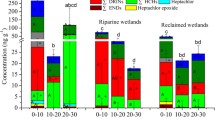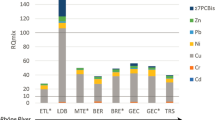Abstract
Purpose
River impoundments disrupt natural water flow patterns and sediment distribution throughout the impacted reach, which often results in a damaging effect on aquatic ecosystems. Dam removal can release sediments that may contain fugitive agricultural nutrients and organochlorine pesticide residues (OCPRs).
Methods
Sediment samples from an impoundment on the Oostanaula Creek (HUC 03,565,432) in Athens, Tennessee, were obtained, as were surface soil samples from the agricultural watershed. A subset of cores were used for simulated weathering, and all samples were extracted and analyzed for nutrients and OCPRs.
Results
The impoundment sediments tested low in P and K, but sediment pore water contained elevated concentrations of NO3, NH4, and SO4 relative to reservoir water. Endrin aldehyde and p,p’-DDD were commonly detected in sediment and soil, while aldrin, dieldrin, and p,p’-DDE occurred in a smaller number of samples. When detected, dieldrin and endrin aldehyde frequently exceeded the threshold effect concentration (TEC), but never exceeded the probable effect concentration (PEC) in the sediment samples; p,p’-DDD always exceeded TEC and exceeded PEC in 49% of the sediment samples. The concentrations of NO3 and NH4 in the weathered sediment leachates were similar to those in the reservoir water, and NH4 became the dominant cation in leachates at the conclusion of simulated weathering. Weathering decreased sediment p,p’-DDD concentrations to less than the PEC; however, the concentrations of other OCPRs were not influenced.
Conclusion
The dam sediments may have harmful effects on sediment-dwelling organisms and a long-term impact on stream reclamation following low-head dam removal.







Similar content being viewed by others
References
Abbott DE, Essington ME, Mullen MD, Ammons JT (2001) Fly ash and lime-stabilized biosolid mixtures in mine spoil reclamation: simulated weathering. J Environ Qual 30:608–616. https://doi.org/10.2134/jeq2001.302608x
Ahearn DS, Dahlgren RA (2005) Sediment and nutrient dynamics following a low-head dam removal at Murphy Creek, California. Limnol Oceanogr 50:1752–1762. https://doi.org/10.4319/lo.2005.50.6.1752
Aigner EJ, Leone AD, Falconer RL (1998) Concentrations and entantiomeric ratios of organochlorine pesticides in soils from the U.S. corn belt. Environ Sci Technol 32:1162–1168. https://doi.org/10.1021/es970750h
American Rivers (2021) American Rivers Dam Removal Database. figshare. Dataset. https://doi.org/10.6084/m9.figshare.5234068. v8. Accessed 18 June 2021
Ashley JTF, Bushaw-Newton K, Wilhelm M, Boettner A, Drames G, Velinsky DJ (2006) The effects of small dam removal on the distribution of sediment contaminants. Environ Monit Assess 114:287–312. https://doi.org/10.1007/s10661-006-4781-3
ATSDR (2021) Toxicology profile for endrin. Agency for Toxic Substances and Disease Registry. U.S. Department of Health and Human Services
ATSDR (2019) Toxicology profile for DDT, DDE, and DDD. Agency for Toxic Substances and Disease Registry. U.S. Department of Health and Human Services
Bidleman TF, Leone AD (2004) Soil-air exchange of organochlorine pesticides in the Southern United States. Environ Pollut 128:49–57. https://doi.org/10.1016/j.envpol.2003.08.034
Bowen HJM (1979) Environmental chemistry of the elements. Academic Press, London
Cantwell MG, Perron MM, Sullivan JC, Katz DR, Burgess RM, King J (2014) Assessing organic contaminant fluxes from contaminated sediments following dam removal in an urbanized river. Environ Monit Assess 186:4841–4855. https://doi.org/10.1007/s10661-014-3742-5
Carriger JF, Rand GM, Gardinali PR, Perry WB, Tompkins MS, Fernandez AM (2006) Pesticides of potential ecological concern in sediment from South Florida canals: an ecological risk prioritization for aquatic arthopods. Soil Sediment Contam 15:21–45. https://doi.org/10.1080/15320380500363095
Chang A, Warneke J, Page A, Lund L (1984) Accumulation of heavy metals in sewage sludge-treated soils. J Environ Qual 13:87–91. https://doi.org/10.2134/jeq1984.00472425001300010016x
Cornwell JC, Owens MS, Staver LW, Stevenson JC (2020) Tidal marsh restoration at Poplar Island I: transformations of estuarine sediments into marsh soil. Wetlands 40:1673–1686. https://doi.org/10.1007/s13157-020-01294-5
Davies SN, DeWiest RCM (1966) Hydrogeology. Wiley-Interscience, NY
Davis RP, Sullivan SMP, Stefanik KC (2017) Reductions in fish-community contamination following lowhead dam removal linked more to shifts in food-web structure than sediment pollution. Environ Pollut 231:671–680. https://doi.org/10.1016/j.envpol.2017.07.096
De Carvalho PSâM, Zanardi E, Buratini SVâ, Lamparelli MCâ, Martins MC (1998) Oxidizing effect on metal remobilization and Daphnia similis toxicity from a Brazilian reservoir sediment suspension. Water Res 32:193–199. https://doi.org/10.1016/S0043-1354(97)00186-3
De Groot CJ, Golterman HL (1993) On the presence of organic phosphate in some Camargue sediments: evidence for the importance of phytate. Hydrobiologia 252:117–126. https://doi.org/10.1007/s10533-006-9049-z
Doyle MW, Harbor JM, Stanley EH (2003) Toward policies and decision-making for dam removal. Environ Manag 31:453–465. https://doi.org/10.1007/s00267-002-2819-z
Duncan, L, Savoy H, Florence R, McClure A, Raper T, Walker F, Essington M, Buschermohle M, Jagadamma S, Hawkins S, Tyler D, Allen G, Qualls D, Wilson J (2019) UT fertilizer recommendation development. University of Tennessee Extension Report W795
Essington ME (1991) Laboratory weathering of combusted oil shale. J Environ Qual 20:794–801. https://doi.org/10.2134/jeq1991.00472425002000040014x
Evans JE, Gottgens JF (2007) Contaminant stratigraphy of the Ballville Reservoir, Sandusky River, NW Ohio: implications for dam removal. J Great Lakes Res 33:182–193. https://doi.org/10.3394/0380-1330(2007)33[182:CSOTBR]2.0.CO;2
Gilliom RJ, Barbash JE, Crawford CG, Hamilton PA, Martin JD, Nakagaki N, Nowell LH, Scott JC, Stackelberg PE, Thelin GP, Wolock DM (2006) The quality of our nation’s waters: pesticides in the nation’s streams and groundwater, 1992–2001. U.S. Geol Surv Circ 1291
Harner T, Wideman JL, Jantunen LMM, Bidleman TF, Parkhurst WJ (1999) Residues of organochlorine pesticides in Alabama soils. Environ Pollut 106:323–332. https://doi.org/10.1016/S0269-7491(99)00110-4
Hart DD, Johnson TE, Bushaw-Newton KL, Horwitz RJ, Bednarek AT, Charles DF, Kreeger DA, Velinsky DJ (2002) Dam removal: challenges and opportunities for ecological research and river restoration. Bioscience 52:669–681. https://doi.org/10.1641/0006-3568(2002)052[0669:DRCAOF]2.0.CO;2
Hillbricht-Ilkowska A (1999) Shallow lakes in lowland river systems: role in transport and transformations of nutrients and in biological diversity. Hydrobiologia 408–409:349–358. https://doi.org/10.1023/A:1017034813729
Huang HJ, Liu SM, Kuo CE (2001) Anaerobic biodegradation of DDT residues (DDT, DDD, and DDE) in estuarine sediment. J Environ Sci Health B36:273–288. https://doi.org/10.1081/PFC-100103569
Huangfu Y, Essington ME, Hawkins SA, Walker FR, Schwartz JS, Layton AC, Hull RA (2019) Evaluation of nitric acid extraction of elements from soils and sediments in two watersheds in east Tennessee. Commun Soil Sci Plant Anal 50:1358–1369. https://doi.org/10.1080/00103624.2019.1614611
Jorgenson JL (2001) Aldrin and dieldrin: a review of research on their production, environmental deposition and fate, bioaccumulation, toxicology, and epidemiology in the United States. Environ Health Perspect 109(Supplement 1):113–139. https://doi.org/10.1289/ehp.01109s1113
Kleeberg A, Heidenreich M (2004) Release of nitrogen and phosphorus from macrophyte stands of summer dried out sediments of a eutrophic reservoir. Archiv Hydrobiologie 159:115–136. https://doi.org/10.1127/0003-9136/2004/0159-0115
Lafrenz MD, Bean RA, Uthman D (2013) Soil ripening following dam removal. Phys Geogr 34:124–135. https://doi.org/10.1080/02723646.2013.799033
MacDonald DD, Ingersoll CG, Berger TA (2000) Development and evaluation of consensus-based sediment quality guidelines for freshwater ecosystems. Arch Environ Contam Toxicol 39:20–31. https://doi.org/10.1007/s002440010075
Mansouri A, Cregut M, Abbes C, Durand MJ, Landoulsi A, Thouand G (2017) The environmental issues of DDT pollution and bioremediation: a multidisciplinary review. Appl Biochem Biotechnol 181:309–339. https://doi.org/10.1007/s12010-016-2214-5
Margolis BE, Castro MS, Raesly RL (2001) The impact of beaver impoundments on the water chemistry of two Appalachian streams. Can J Fish Aquat Sci 58:2271–2283. https://doi.org/10.1139/f01-166
Mehlich A (1984) Mehlich 3 soil test extractant: a modification of Mehlich 2 extractant. Commun Soil Sci Plant Anal 15:1409–1416. https://doi.org/10.1080/00103628409367568
Meijer SN, Shoeib M, Jantunen LMM, Jones KC, Harner T (2003) Air-soil exchange of organochlorine pesticides in agricultural soils. 1. Field Measurements Using a Novel in Situ Sampling Device Environ Sci Technol 37:1292–1299. https://doi.org/10.1021/es020540r
Persaud D, Jaagumagi R, Hayton A (1993) Guidelines for the protection and management aquatic sediment quality in Ontario. Water Resources Branch, Ontario Ministry of the Environment, Toronto, 27
Phillips PJ, Nowell LH, Gilliom RJ, Nakagaki N, Murry KR, VanAlstyne C (2010) Composition, distribution, and potential toxicity if organochlorine mixtures in bed sediments of streams. Sci Total Environ 408:594–606. https://doi.org/10.1016/j.scitotenv.2009.09.052
Pizzuto J (2002) Effects of dam removal on river form and process. Bioscience 52:683–691
Poff NL, Hart DD (2002) How dams vary and why it matters for the emerging science of dam removal. BioScience 52:659–668. https://doi.org/10.1641/0006-3568(2002)052[0659:HDVAWI]2.0.CO;2
Shuman JR (1995) Environmental considerations for assessing dam removal alternatives for river restoration. Reg Rivers: River Manag 11:249–261. https://doi.org/10.1002/rrr.3450110302
Stanley EH, Doyle MW (2002) A geomorphic perspective on nutrient retention following dam removal. BioScience 52:693–701. https://doi.org/10.1641/0006-3568(2002)052[0693:AGPONR]2.0.CO;2
Szeto SY, Price PM (1991) Persistence of pesticide residues in mineral and organic soils in the Fraser Valley of British Columbia. J Agric Food Chem 39:1679–1684. https://doi.org/10.1021/jf00009a027
Tate CM, Heiny JS (1996) Organochlorine compounds in bed sediment and fish tissue in the South River Basin, USA, 1992–1993. Arch Environ Contam Toxicol 30:62–78. https://doi.org/10.1007/BF00211330
Tschantz BA, Wright KR (2011) Hidden dangers and public safety at low-head dams. J Dam Safety 9:9–17
Tullos DD, Collins MJ, Bellmore JR, Bountry JA, Connolly PJ, Shafroth PB, Wilcox AC (2016) Synthesis of common management concerns associated with dam removal. J Am Water Resource Assoc 52:1179–1206. https://doi.org/10.1111/1752-1688.12450
USEPA (1996) Method 3540c: soxhlet extraction. Available at https://www.epa.gov/sites/production/files/2015-12/documents/3540c.pdf. Accessed 18 Dec 2019
USEPA (2007) Method 8081b: organochlorine pesticides by gas chromatography. Available at https://www.epa.gov/sites/production/files/2015-12/documents/8081b.pdf. Accessed 18 Dec 2019
Wan MT, Kuo J, Pasternak J (2005) Residues of endosulfan and other organochlorine pesticides in farm areas of the Lower Fraser Valley, British Columbia, Canada. J Environ Qual 34:1186–1193. https://doi.org/10.2134/jeq2004.0361
Wang W, Delgado-Moreno L, Conkle JL, Anderson M, Amrhein C, Ye Q, Gan J (2012) Characterization of sediment contamination patterns by hydrophobic pesticides to preserve ecosystem functions of drainage lakes. J Soils Sediments 12:1407–1418. https://doi.org/10.1007/s11368-.12-0560-7
Yang L, Li X, Zhang P, Melcer ME, Wu Y, Jans U (2012) Concentrations of DDTs and dieldrin in Long Island Sound sediment. J Environ Monit 14:878–885. https://doi.org/10.1039/c2em10642f
Yang YY, Toor GS, Williams CF (2015) Pharmaceuticals and organochlorine pesticides in sediments of an urban river in Florida, USA. J Soils Sediments 15:993–1004. https://doi.org/10.1007/s11368-015-1077-7
Acknowledgements
We also thank Ms. Galina Melnichenko and Ms. Melanie Stewart of the Biosystems Engineering and Soil Sciences Department’s Soil and Water Quality Laboratory for their expertise in analyzing the soil and sediment samples.
Funding
Financial support of this research by USEPA project number A16-0345 is gratefully acknowledged.
Author information
Authors and Affiliations
Corresponding author
Ethics declarations
Conflict of interest
The authors declare no competing interests.
Additional information
Responsible editor: Jan Schwarzbauer
Publisher's Note
Springer Nature remains neutral with regard to jurisdictional claims in published maps and institutional affiliations.
Supplementary information
Below is the link to the electronic supplementary material.
Rights and permissions
About this article
Cite this article
Essington, M.E., Ludwig, A.L., Essington, E.A. et al. Persistence of organochlorine pesticide residues in sediments derived from an agricultural watershed in Tennessee, USA. J Soils Sediments 22, 1852–1864 (2022). https://doi.org/10.1007/s11368-022-03220-0
Received:
Accepted:
Published:
Issue Date:
DOI: https://doi.org/10.1007/s11368-022-03220-0




